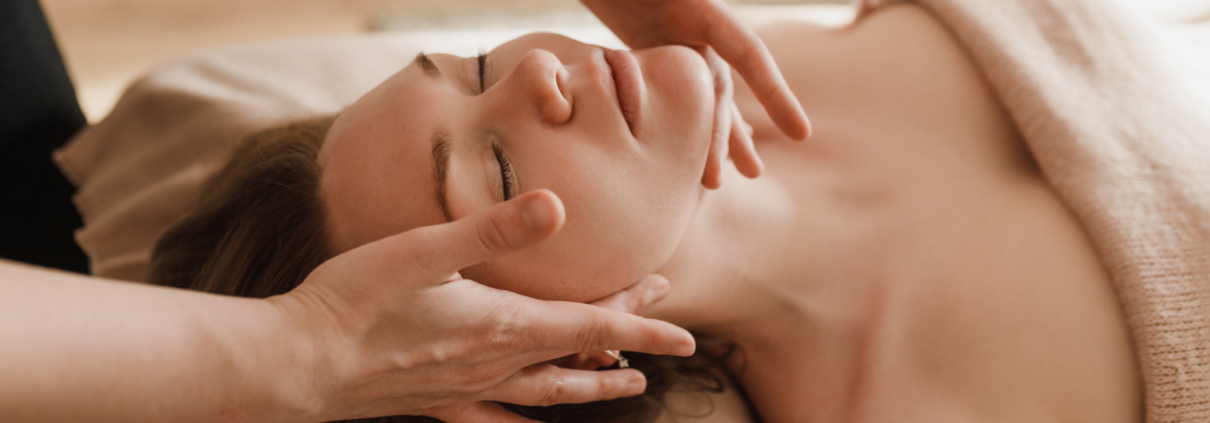Why facial therapy is more than skin deep
Facial tension, jaw pain, tension in the neck and shoulders…sound familiar?
These are common symptoms of our daily habits – far too many hours spent with technology causing achy shoulders and a tired neck, but have you ever thought about the impact on your face and jaw?!
It can take days, months and even years before the tension appears but other tell-tale signs can include headaches, teeth clenching, teeth grinding (TMJD), tech-neck and a face that feels tired and has a lack lustre appearance
As a well-seasoned integrated manual therapist and with my own aches and pains, I am acutely aware of approaching and treating the body as a whole and understand an interruption in one area will always impact somewhere along the bodies intricate lines of fascial communication.
One of my favourite areas of interest is the amazing network of facial muscles and their significant anatomical link to the scalp, neck, shoulders and even the pelvis. In my experience, many clients often sense the tension in the face first, the spine and the body following (versus the other way around) as hunching over in our everyday activities and prolonged periods of tilting our heads often results in a huge amount of stress permeating the face, particularly the jaw, neck, and shoulders.
Did you know when the head is in a neutral position it weighs approximately 10-12 lbs but with a forward head posture, looking down at a 15 degree angle the amount of weight increases to an incredible 27 lbs and with a 30-degree tilt, 40 lbs!! It is no wonder that constantly looking at screens can cause some pain!
The architecture of our faces and the link with emotional well being
Skin is our largest sensory organ and there are over 24 muscles individual muscles on each side of the face, linking the skin of the face to the bony skull primed to perform our vital functions for daily life: chewing and the expression of emotion via facial expressions. Any interruption (tension) to this delicate symphony may well be the culprit to not only feeling tension but also a tired complexion.
Research has shown that skin senses external information in a similar pattern to the brain such as assessing the strength of light, colour and sound which therefore links our physical and emotional worlds. Due to this, during a period of increased stress our cortisol levels rise, triggering a hormonal cascade in the body which ca affect our sleep, energy levels and ultimately the way we look and feel.
The tension built up in our neck and face can also deprive the facial tissues of moisture – also known as hyaluronan and a host of other lubricating factors that enable fluids to glide within the tissues, this leads to your circulation and other important aspects of movement to be compromised. So, it makes perfect session that we notice how sallow and tired our complexion appears with increased tension.
An informed use of touch, particularly to the face, has been shown to lower blood pressure, heart rate and cortisol levels, stimulate the memory center of the brain, and drive the release of a host of hormones that link to positive and uplifting emotions, as found by Tiffany Filed, the head of the Touch Research Institute at the University of Miami’s Miller School of Medicine also proving that long term stress delays the skin barrier recovery.
So how does facial therapy help?
Facial therapy offers a range of manual therapy techniques such as clinical massage to address the deep seated tension, instrument assisted soft tissue mobilization (IASTM) and acupressure. Extending a treatment beyond the face to incorporate the scalp, neck and shoulders are key factors for addressing and successfully treating chronic tension. If your jaw is the main culprit, external and intra-oral techniques are utilised depending on your comfort level and requirements with exercises designed to strengthen the muscles of the jaw and neck as a home care option.
One of the main benefits of facial massage is its ability to improve the overall appearance of skin, the results of facial therapy are often a reduction in puffiness, a visible difference to the firmness of the skin and that covetable healthy, rested glow – an unexpected bonus!
My top 3 simple tips for improving face and neck tension
- Posture: think about lifting your chest to make the space between your ribs and pelvis lengthen and as you inhale and exhale, bring your awareness to your shoulders, letting them drop as much as possible. Note how much easier it is to breathe and how the balanced the head feels on top of your spine
- Jaw tension: placing your fingers below your cheek bone in front of your ears, clench your teeth together to feel those chewing muscles in action. Slowly, very slowly, press into the muscles with the pads of your fingertips and glide down towards the jaw line. You can also use your knuckles.
- Face massage: Try opening your mouth and gently rubbing the muscles next to your ears on either side of your face in a circular motion, incorporating the cheeks and forehead.
References:
Facial Expressions of Emotion Reveal Neuroendocrine and Cardiovascular Stress Responses:
https://www.sciencedirect.com/science/article/pii/S0006322306010614
Social touch, CT touch and massage therapy: A narrative review:
https://www.sciencedirect.com/science/article/pii/S0273229718300510
The effects of anxiety and frustration on muscular tension related to the temporomandibular joint syndrome:
https://www.sciencedirect.com/science/article/pii/0030422073901539















